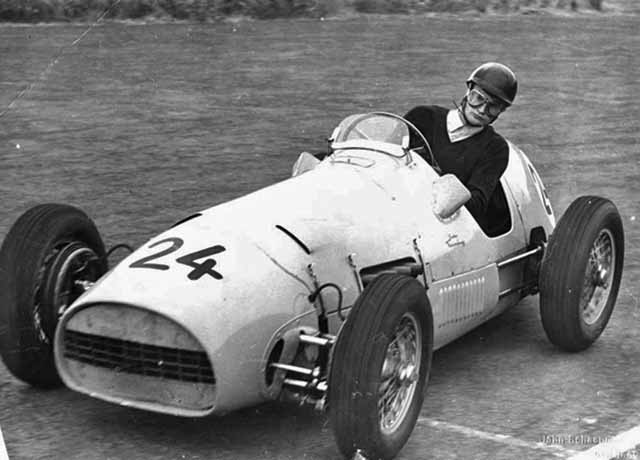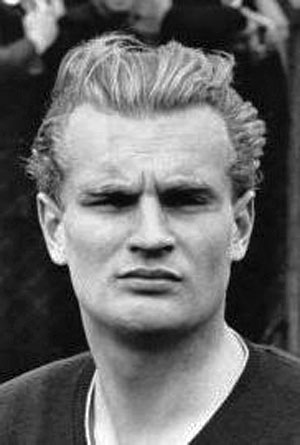Charles de Tornaco (7 June 1927 – 18 September 1953) was a racing driver from Belgium.
He participated in 4 Formula One World Championship Grands Prix, debuting on 22 June 1952. He scored no championship points.
De Tornaco was the co-founder of Ecurie Belgique, which later became Ecurie Francorchamps, and most of his racing career was with this team, driving Ferraris. In practice for the Modena Grand Prix in 1953, de Tornaco rolled his car and suffered serious head and neck injuries. There were no adequate medical facilities present, and he died on his way to hospital in a private saloon car. Info from Wiki
Baron Charles Victor Raymond André Evance de Tornaco
Or just Charles de Tornaco for short. Slick and sexy Charles de Tornaco.
And a Baron too, if you noticed his official title in his name. He was born into the noble De Tornaco family, which is lucky enough. His great-grandfather was the prime minister of Luxembourg. His great-great grandfather was the mayor of Luxembourg City, assigned to that role by none other than Napoleon himself.
He sure had the aristocracy most gentleman drivers of the day were associated with back then, but peculiarly for him, he also had a fair dosage of racing heritage in his blood as well. His father was an early pioneer in Belgian motorsport and participated in lots of pioneering endurace races. He finished third in the first ever 24 Hours of Le Mans in 1923 and came home third again at the inaugural 24 Hours of Spa the following year.
So born into a select family with both the cash and racing pedigree behind them, it seemed it would be only natural for the young Charles de Tornaco to enter motorsport in some respect. He would need some pathways into the sport though, and that’s where two of his friends come in…
Whilst studying in Louvian University just after the end of the Second World War, he made some amazing friends in Jacques Swaters and Andre Pilette, son of Indy 500 driver Theodore. Together, the three would enjoy their days going flat out on country roads, probably in the fifties equivalent to rich kids in their inherited supercars blasting noise through the neighbourhood today. Having inherited his late father’s hefty fortune after he died in the war, Swaters in particular had a sizable enough wallet to give up studying law andstart up his own garage in Brussels. De Tornaco and Pilette were only too happy to pitch in, being driven to follow in their father’s footsteps in motor racing.
Driven as they were though, Charles de Tornaco was still probably the silliest of the bunch. The most notable example of this was a notable incident before the 1948 Spa 24 Hours. Swaters managed to get a hold of an old MG that had finished well in its class in the 24 hours of Le Mans all the way back in 1938. About to make his first entry into the 24 Hours of Spa with Paul Frere, Swaters was persuaded by de Tornaco to lend the car to him for a joyride around the university. Naturally, de Tornaco returned to the garage with a smoking engine and, somehow, a discoloured camshaft. All of this just two days before scrutineering.
Somehow, even with de Tornaco’s antics, Frere and Swaters managed to repair the car in time to finish an incredible 4th. The next year, de Tornaco would be shown how tough a 24 hour race around Spa Francorchamps really was, as he paired Swaters in a BMW 328, though he would fail to find the finish.
By then, the trio of de Tornaco, Swaters and Pilette were aiming for bigger and better heights. They all banded together to purchase an old Talbot-Lago Grand Prix for the upcoming season for one reason only. Some new, pinnacle of motor racing with an official driver’s championship going by the name of Formula 1.
Taking to the Formula One circuit, Ecurie Belgique didn’t really set the world alight in Formula One, especially with their aging Talbot-Lago chassis. Charles de Tornaco sat by the sidelines in Formula One, preferring to ply his trade in Formula Two first in a Veritas. Andre Pilette injured himself in the Dutch Grand Prix, forcing Swaters into the car for Germany and Italy to middling results. In any case, results wasn’t their biggest concern at the time.
That would be the RACB, the Royal Automobile Club of Belgium. You see, the teenage trio of de Tornaco, Swaters and Pilette were not the only three Belgian drivers on the grid, quite obviously. There would also be the factor of one Johnny Claes, former jazz musician turned Belgian interpreter turned racing driver. He bit the Formula One cherry earlier than Ecurie Belgique, setting up a team running Talbot-Lagos in 1950. The name of that team?
Ecurie Belge.
Understandably, when Swaters popped out of the blue with Ecurie Belgique, the RACB was none too pleased, citing confusion between Claes and Swaters’ outfits as the main reason. Because Claes had been using that name this entire time, the RACB demanded that Ecurie Belgique find a new name and fast. Swaters initially contemplated representing Luxembourg, given Charles de Tornaco’s extensive family history there (Remember. His ancestor was assigned as a mayor by NAPOLEON.), but ditched it all to associate the name with a fairly well known circuit in the area: Ecurie Francorchamps.
Alongside the name change, there was also quite the buzz going around the paddock. The World Drivers Championship was changing its’ regulations, opting to use Formula Two Specifications for 1952. For most major manufacturers, most notably Alfa Romeo, this was an insult. For best buds de Tornaco and Swaters, this was a blessing in disguise. Somehow, the pair at Ecurie Francorchamps managed to form a strong bond with Ferrari, somehow purchasing a 166 from the individual who would go on to spearhead FIAT, Gianni Angelli. Likewise, they developed a close partnership with the head of Ferrari’s commercial department at the time, Girolamo Gardini. They ordered a Ferrari 500, the exact same chassis that Ascari would go on to dominate in, for de Tornaco to race in 1952.
It’s first outing was to be in the non-championship race in Chimay, however the car was pushing its schedule. With the car only completed at the last minute, Swaters had no choice but to drive the damn thing, on public roads, from Italy to Chimay, literally ducking under border checkpoints just to get to the circuit on time. Peculiarly, it was Roger Laurent, another friend of de Tornaco and Swaters that jumped in the 500 instead, with de Tornaco taking over Laurent’s original entry in the HWM.
In that race, the Belgian-Luxembourgish nobleman known for his long, slicked back hairstyle and fancy suits while racing made his racing pedigree known, finishing a respectable fifth that event.
No doubt bouyed by that finish and the beautiful Ferrari 500 waiting for him in the Francorchamps garage, Ecurie Francorchamps entered de Tornaco for the Belgian Grand Prix. Despite being well behind Ascari in qualifying by a full 40 seconds around the 15 kilometre track, he did great in comparison to the rest of the field. For his first World Championship race, he qualified a respectable thirteenth and finished an even more spectacular seventh out of fifteen finishers.
The nobleman would never reach those dizzying heights in Formula One again, though. He failed to finish in the Netherlands while running at the back for the majority of the race, and even failed to qualify at the Ferrari’s home race in Italy.
There would be one more shining light in the young nobleman’s career, though. In 1953, a certain bloke Ian Appleyard ordered a Jaguar C-type for the Alpine Rally. However, upon inspection, the car had been setup for high-speed events by mistake, so Appleyard put the car up for sale. This was taken by one Roger Laurent. Remember him? The guy who was the first driver to take on the Francorchamps Ferrari at Chimay? Laurent passed the car over to Swaters and de Tornaco in the Francorchamps garage, who saw a perfect opportunity with the car. They’d take it to Le Mans.
With Laurent back on board and de Tornaco partnering him, the standard C-Type looked to be nowhere near as competitive as the factory Jaguars, with their own special Lightweight bodies, extra horsepower and innovative disc brakes. As such, they expected to be nowhere in the race. But even in a bog-standard version of the Jaguars that would finish 1-2-4, de Tornaco and Laurent managed to pull the car all the way up to ninth in the event, impressing even the Jaguar bosses, who would go on to develop a close partnership with Ecurie Francorchamps in the coming years.
Sadly for de Tornaco, he never got to see those coming years. After a disastrous Belgian Grand Prix, where the two Ecurie Francorchamps Ferraris of de Tornaco and Swaters had to pull out before practice, the group of friends opted to enter a few non-championship events to iron out whatever they had wrong with those cars. One of those events would be the Grand Prix of Modena. Oddly, in the birthplace of Enzo Ferrari, there were no works Ferraris to be seen. Enzo himself had a massive spat with the organizers of the event, thus withdrawing all of his works Ferraris from the event. As such, Baron Charles de Tornaco was going to be the only Ferrari entrant in the event, his 500 painted in the bright yellow of Ecurie Francorchamps.
In practice, though, the Ferrari wasn’t going spectacularly fast for de Tornaco. On the northern straight of the circuit, de Tornaco turned his head to see the two Connaughts of Roy Salvadori and Johnny Claes hounding his tail. He lost control of his Ferrari while looking back, and as such it ventured into the run off area. The car hit a rut, half ejecting de Tornaco and flipping over. This unfortunate incident crushed and fractured de Tornaco’s skull. With no doctor in sight, no medical facilites at the track and not even an ambulance, the young Baron died as he was being rushed to hospital in the back of a private car at just 26 years old. His best friend, Jacques Swaters, was in Belgium at the time. He only heard about the incident through a telephone call with his Ferrari associate, Giralmo Gardini. He was the one who had to break the news to the De Tornaco family. Up until his death in 2010, Swaters was haunted by the fact that he wasn’t there alongside his best friend as he passed.
With all the lack of sources I could find about the guy, this was still the most fun I’ve had writing one of these since my thing on Ken Richardson. Seriously, I had lots of fun writing about the second sexiest Formula One driver from the 50’s.




